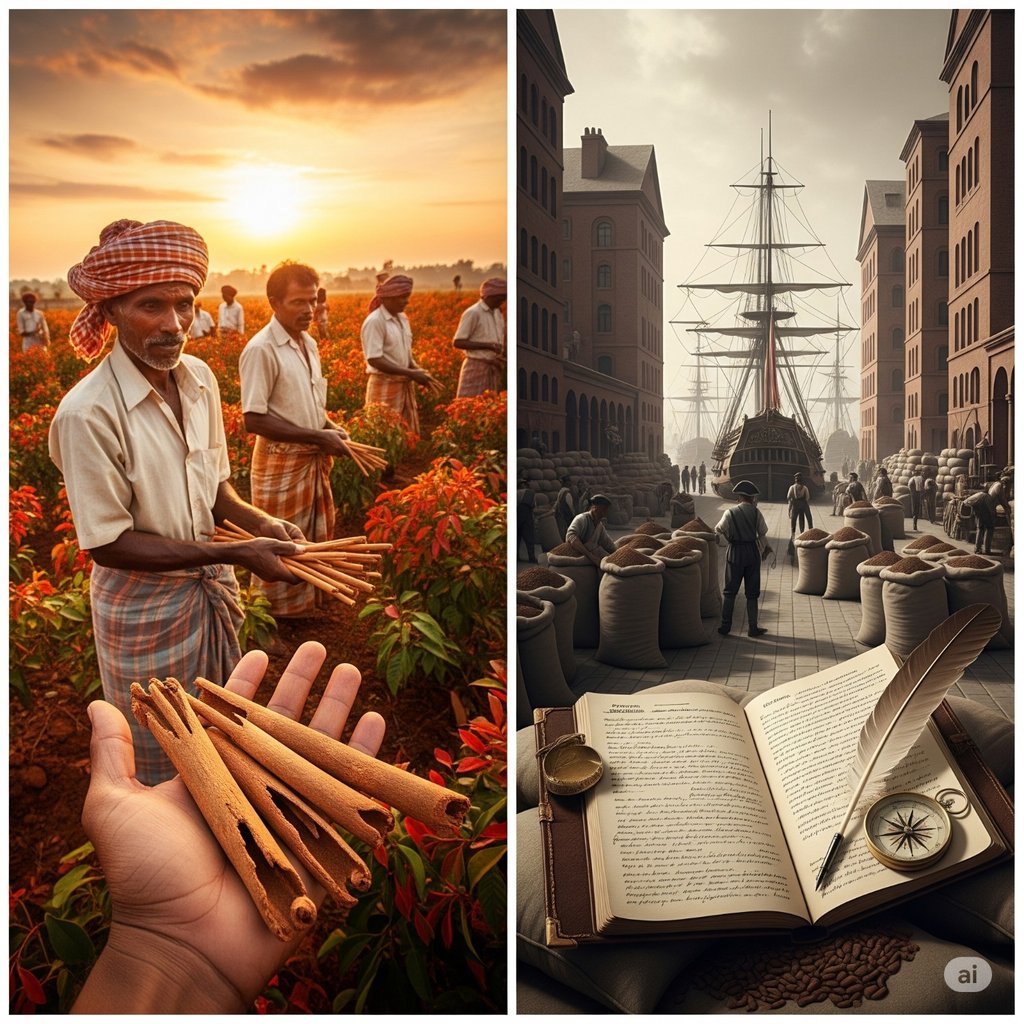The Golden Threads of Flavor: How Indian Spices Wove History, Freedom, and Economy
For millennia, the air over India has carried whispers of something more precious than gold, more coveted than silk: the intoxicating aroma of spices. Let’s journey through time to explore the profound role Indian spices played in ancient India, the brutal colonial period, the freedom struggle, and the very fabric of the Indian economy and people's lives.


The Golden Threads of Flavor: How Indian Spices Wove History, Freedom, and Economy
For millennia, the air over India has carried whispers of something more precious than gold, more coveted than silk: the intoxicating aroma of spices. At Vakkratunda Exotic Blends, as custodians of the finest spices under our Navann brand – from the fiery kick of Black Pepper to the warm embrace of Ceylon Cinnamon, the sweet perfume of Cardamom, and the earthy depth of Turmeric Powder – we don't just sell ingredients; we offer fragments of a history that shaped civilizations and ignited revolutions. Let’s journey through time to explore the profound role Indian spices played in ancient India, the brutal colonial period, the freedom struggle, and the very fabric of the Indian economy and people's lives.
Ancient India: Spices as Liquid Gold and Cultural Cornerstones
Long before empires rose and fell, Indian spices were already legendary.
The Economic Engine: Ancient India wasn't just an agricultural society; it was a spice superpower. Black Pepper ("Black Gold"), Cardamom, Cinnamon, and Cloves (primarily grown in the Malabar coast and Southern regions) were central to a vast trade network stretching to Mesopotamia, Egypt, Rome, and eventually China. This trade wasn't minor; it was the lifeblood of kingdoms. Revenue from spice exports funded grand temples, mighty armies, and flourishing cities. Spices were a significant portion of the nation's wealth generation, long before the concept of GDP existed. They attracted merchants from across the globe, turning Indian ports like Muziris into bustling international hubs.
Beyond the Plate: Spices permeated every aspect of life. Turmeric Powder wasn't just for curries; it was sacred in rituals, a vibrant dye, and a cornerstone of Ayurvedic medicine (alongside Cumin Seeds, Mustard Seeds, and Coriander Powder). Kashmiri Chilli Powder (though arriving later from the Americas) eventually became integral to regional cuisines and preservation. Cloves and Cardamom freshened breath and were used in perfumes. Spices defined social customs, religious practices, and daily wellness.
The Colonial Period: The Bitter Taste of Exploitation
The very wealth spices generated became India's curse when European powers set their sights on the subcontinent.
The Spice Race & Monopoly: The Portuguese, Dutch, French, and finally the British fought brutal wars, not primarily for territory initially, but for control over the spice trade routes and production centers. Companies like the Dutch East India Company (VOC) and the British East India Company (EIC) established monopolies. They manipulated local rulers, engaged in ruthless price-fixing, and often used force to control regions producing Pepper, Cardamom, and Cinnamon.
Economic Drain & Devastation: Colonial rule systematically dismantled India's prosperous spice trade. Indigenous merchants were sidelined or ruined. Revenue from spices flowed out of India, enriching European coffers and shareholders while impoverishing the land that produced them. This was a massive drain of wealth, crippling the local economy. Traditional farming practices were often disrupted, and farmers were forced into exploitative contracts, growing cash crops (including spices) for export at the expense of food security.
Impact on People: The colonial spice monopoly meant lower prices for Indian growers and exorbitant prices for Indian consumers for their own produce. This exploitation, coupled with famines exacerbated by colonial policies focusing on cash crops, led to immense suffering and declining living standards for millions. The wealth generated by Mustard Seeds, Cumin Seeds, and Coriander Powder filling European storehouses contrasted sharply with the poverty in the villages where they were grown.
Spices and the Seeds of Freedom
The injustice inherent in the colonial exploitation of India's resources, including its spices, became a powerful catalyst for resistance.
Symbol of Exploitation: Nationalist leaders like Dadabhai Naoroji meticulously documented the "Economic Drain" theory, highlighting how resources like spices were siphoned off, impoverishing India. Spices became a potent symbol of colonial plunder.
Gandhi & Swadeshi: Mahatma Gandhi's Swadeshi movement was a direct response to this economic exploitation. It urged Indians to boycott British goods and revive indigenous industries. While famously targeting salt and cloth, the spirit of Swadeshi extended to reclaiming control over agricultural produce, including spices. Using locally grown Turmeric, Chillies, Coriander, and Cumin became an act of self-reliance and defiance. Supporting Indian farmers and spice merchants was supporting the fight for freedom.
Economic Nationalism: The freedom struggle increasingly linked political independence with economic independence. Regaining control over vital resources like spices was seen as essential for India's future prosperity and self-determination. The struggle wasn't just against political rule, but against the economic structures that kept India subservient.
The Legacy: Shaping Modern India
The echoes of this spicy history resonate today:
Economic Pillar: Spices remain a vital part of the Indian economy. India is still the world's largest producer, consumer, and exporter of many spices, including Black Pepper, Cardamom, Turmeric, and Chillies. The spice industry contributes significantly to agricultural GDP, provides livelihoods for millions of farmers and workers, and earns crucial foreign exchange.
Cultural Identity: Indian cuisine, defined by its masterful blend of Navann spices – the warmth of Cinnamon, the bite of Cloves, the citrusy notes of Coriander Powder, the pungency of Mustard Seeds, the earthiness of Cumin – is a source of immense national pride and a global ambassador for Indian culture.
Wellness Renaissance: The ancient wisdom of Ayurveda, where Turmeric, Cumin, Coriander, Cardamom, and Mustard Seeds play starring roles, is experiencing a global resurgence, validating their timeless health benefits.
Experience the Legacy with Navann by Vakkratunda Exotic Blends
When you choose Navann spices, you're not just adding flavor to your food; you're connecting with a heritage that is thousands of years old. You're tasting the essence that:
Fueled ancient economies and built civilizations.
Drew explorers across treacherous oceans and ignited colonial conquests.
Became a symbol of exploitation and, ultimately, a spark for freedom.
Continues to sustain millions of farmers and define a nation's palate and wellness.
Our commitment at Vakkratunda Exotic Blends is to bring you these legendary spices – Black Pepper, Cardamom, Ceylon Cinnamon, Cloves, Kashmiri Chilli Powder, Turmeric Powder, Coriander Powder, Mustard Seeds, Cumin Seeds – in their purest, most vibrant form. We honor the farmers, the history, and the incredible journey these spices have taken from our soil to your kitchen.
Explore the taste of history. Discover the essence of India. Choose Navann.
Visit www.vakkratunda.com today and bring home a piece of India's glorious, spicy legacy!

